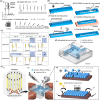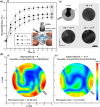Magnetic Cilia with Programmable Beating Patterns for Vortex-Driven Mixing in Microfluidics
- PMID: 40739946
- PMCID: PMC12369015
- DOI: 10.1021/acs.langmuir.5c02350
Magnetic Cilia with Programmable Beating Patterns for Vortex-Driven Mixing in Microfluidics
Abstract
Artificial cilia are widely employed in microfluidic platforms, where their beating motion is harnessed to emulate the fluid transport capabilities of natural motile cilia. In particular, metachronal beating, characterized by phase-shifted motion among adjacent cilia, has proven to be effective for directional fluid transport. However, its potential for micromixing remains limited due to its inherently planar wave propagation, which offers room for improvement in generating strong vortices. To address this, three magnetically actuated artificial cilia carpets are fabricated with identical structural designs featuring spatially varied cilia orientations to embed controlled orientational asymmetry. To realize distinct motion patterns, each carpet is magnetized with a single, unique magnetization profile such that one carpet corresponds to one beating mode, including synchronous, symplectic metachronal, or antiplectic metachronal, and is actuated externally to generate its respective motion. For demonstration purposes, two different experiments are conducted, including micromixing and photocatalytic dye degradation. The results reveal that metachronal motion alone is insufficient to enhance micromixing, thereby highlighting the need for integration with orientational asymmetry. Compared to the aligned cilia carpet (control), superior mixing efficiency of 87% and a 3-fold enhancement in dye degradation are observed in the inclined cilia carpet actuated with antiplectic metachronal motion. This enhanced hydrodynamic activity is further substantiated through μPIV experiments. These findings define metachrony as a dual-function paradigm for both fluid propulsion and vortex-enabled microfluidic mixing.
Figures





Similar articles
-
Prescription of Controlled Substances: Benefits and Risks.2025 Jul 6. In: StatPearls [Internet]. Treasure Island (FL): StatPearls Publishing; 2025 Jan–. 2025 Jul 6. In: StatPearls [Internet]. Treasure Island (FL): StatPearls Publishing; 2025 Jan–. PMID: 30726003 Free Books & Documents.
-
Management of urinary stones by experts in stone disease (ESD 2025).Arch Ital Urol Androl. 2025 Jun 30;97(2):14085. doi: 10.4081/aiua.2025.14085. Epub 2025 Jun 30. Arch Ital Urol Androl. 2025. PMID: 40583613 Review.
-
Metachronal patterns by magnetically-programmable artificial cilia surfaces for low Reynolds number fluid transport and mixing.Soft Matter. 2022 May 25;18(20):3902-3909. doi: 10.1039/d1sm01680f. Soft Matter. 2022. PMID: 35535750
-
Short-Term Memory Impairment.2024 Jun 8. In: StatPearls [Internet]. Treasure Island (FL): StatPearls Publishing; 2025 Jan–. 2024 Jun 8. In: StatPearls [Internet]. Treasure Island (FL): StatPearls Publishing; 2025 Jan–. PMID: 31424720 Free Books & Documents.
-
[Volume and health outcomes: evidence from systematic reviews and from evaluation of Italian hospital data].Epidemiol Prev. 2013 Mar-Jun;37(2-3 Suppl 2):1-100. Epidemiol Prev. 2013. PMID: 23851286 Italian.
References
-
- Purcell E. M.. Life at low Reynolds number. Am. J. Phys. 1977;45(1):3–11. doi: 10.1119/1.10903. - DOI
-
- Razavi Bazaz S., Sayyah A., Hazeri A. H., Salomon R., Abouei Mehrizi A., Ebrahimi Warkiani M.. Micromixer research trend of active and passive designs. Chem. Eng. Sci. 2024;293:120028. doi: 10.1016/j.ces.2024.120028. - DOI
-
- Hadjigeorgiou A. G., Boudouvis A. G., Kokkoris G.. Thorough computational analysis of the staggered herringbone micromixer reveals transport mechanisms and enables mixing efficiency-based improved design. Chem. Eng. J. 2021;414:128775. doi: 10.1016/j.cej.2021.128775. - DOI
MeSH terms
LinkOut - more resources
Full Text Sources

